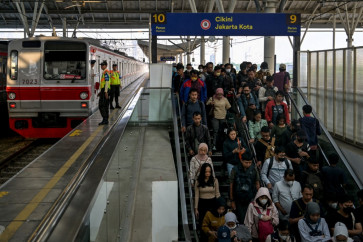Popular Reads
Top Results
Can't find what you're looking for?
View all search resultsPopular Reads
Top Results
Can't find what you're looking for?
View all search resultsWhat it takes for grocers to grow with emerging Asia
These would seem like the best of times for the grocery business in emerging Asia
Change text size
Gift Premium Articles
to Anyone
T
hese would seem like the best of times for the grocery business in emerging Asia. Home to about 44 percent of the world's population, Asia's emerging markets boast macro trends that would delight any retailer: healthy gross domestic product (GDP) growth, a rapidly rising middle class and populations that are steadily moving into cities, where the economics of distribution favor modern trade.
By Bain & Company analysis, 30 percent of the world's retail growth through 2017 will come from Asia's emerging markets.
But if the growth is strong and prospects are bright, why do some companies pull ahead while others follow distantly or fail? India's Big Bazaar grew to US$2.1 billion and earned 6 percent margins in 2012. China's RT-Mart nearly tripled its revenues from 2007 to 2011, and Indonesia's Hero Supermarket watched its revenue growth significantly outpace the total market during those years. However, in the same retailing environment, some of their multinational competitors lost share.
Despite the dazzling macro trends, there are a host of obstacles that make this region a tricky one. In addition to dealing with intensified competition and a fragmented environment, retailers find they need to adapt their strategies to vastly different countries in varying stages of development. They also must grapple with each country's specific challenges: India's poorly developed infrastructure, China's massive urban traffic problems and Indonesia's regulatory and protectionist measures, for example. Grocers find it's not always possible to grab share by repeating a standard or imported formula. Companies need to make critical adjustments.
How to win? We extensively researched grocery retailing in Asia and identified nine rules for success as well as three country-specific considerations. Here's how five of those rules were successfully applied in emerging Asia:
First, build successive local footprints focusing on local share. Growing by sequential geographic cluster allows a company to maintain a low-cost model, which in turn enables it to expand profitably. Among the reasons that Mumbai-based D-Mart is outpacing its rivals with 56 percent growth: D-Mart focused its expansion efforts in western India, which helped the grocer control distribution costs.
It opts to own stores in densely populated areas, as opposed to paying high rents in shopping malls, and maintains no-frills interiors. The retailer uses the savings to fuel steady expansion and also can offer prices that are 6 percent to 7 percent lower than competitors. Its high local relative market share has delivered sales per store that are far above rivals.
Second, learn omnichannel before your competitors do. Grocers in every corner of the world are striving to figure out how to make inroads into online grocery. Local Chinese e-commerce web site Yihaodian grew revenues 27 percent in 2012, in a market where the prospects for online grocery are huge.
Yihaodian has used its dedicated digital team to quickly learn what works and what doesn't in everything from fulfillment to online merchandising to social media. A digital presence is key to the customer value proposition and successful early movers are getting ahead and consolidating their lead.
Third, make fresh food and locally relevant products priorities. Walk into a Hero supermarket anywhere in Indonesia, and you're overwhelmed by fresh food ' it differentiates the retailer from competitors. Hero's procurement initiatives are aimed at making fresh food a priority in its stores. The grocer has demonstrated that a focus on fresh foods doesn't need to be expensive, and keeping costs low can help it maintain the fresh food emphasis.
Hero controls distribution costs by maintaining a centralized and high-tech 20,000-square-meter distribution center near Jakarta. The grocer is increasing its mix of smaller, cost-efficient supermarket formats. As a result, Hero's operating margin was 5 percent in 2011, double that in 2008, while its overhead expenses have dropped. The company's revenue grew 34 percent from 2007 to 2012.
Fourth, establish a low-price perception through frequent promotions and low shelf prices. Consumers in emerging Asia tend to be highly price sensitive. Grocers gain a distinction for being low-price competitors through such efforts as ongoing and frequent consumer promotions, or reducing average shelf price by boosting the number of private-label stock keeping units (SKUs).
In Vietnam, Big C, a wholly owned subsidiary of France's Groupe Casino, relentlessly negotiates with manufacturers and uses its scale to sell products at 5 percent to 10 percent less than the printed price on packaging, often offering promotion discounts of up to 35 percent. Big C dominates in hypermarkets in Vietnam, where revenues grew at an annual 44 percent in Vietnam between 2007 and 2011. In Thailand, Big C uses private labels to strengthen its low-price perception.
Fifth, win the war for talent, especially on the front line. It's no secret that retailers in emerging Asia suffer from a shortage of great store managers, buyers and other frontline talent that can keep a store running smoothly. Any company with a new idea for finding, developing and retaining talent has an edge over rivals. Vietnam's Big C has partnered with more than 30 training and educational institutions, domestic and overseas, educating young people for careers in grocery retail management and offering scholarships and jobs to promising students.
The grocery retail market in emerging Asia is expected to be larger than those in Western Europe and North America by 2017, with multinationals and local companies competing equally aggressively. But the moves that brought a company success in the past ' very often in a different region ' can't simply be repeated here.
Ambitious multinationals with track records of success elsewhere don't necessarily have a right to win. And the same can be said for domestic companies; while they may have an edge when it comes to understanding local consumers and maintaining a low-cost model, they need to learn how to scale effectively.
But by sticking to these nine rules, retailers dramatically improve their odds of success.
Serge Hoffmann is a Bain & Company partner based in Hong Kong, Nader Elkhweet is a partner based in Jakarta and Mike Booker, a partner in Singapore, leads Bain's Consumer Products and Retail practices in Asia-Pacific.










